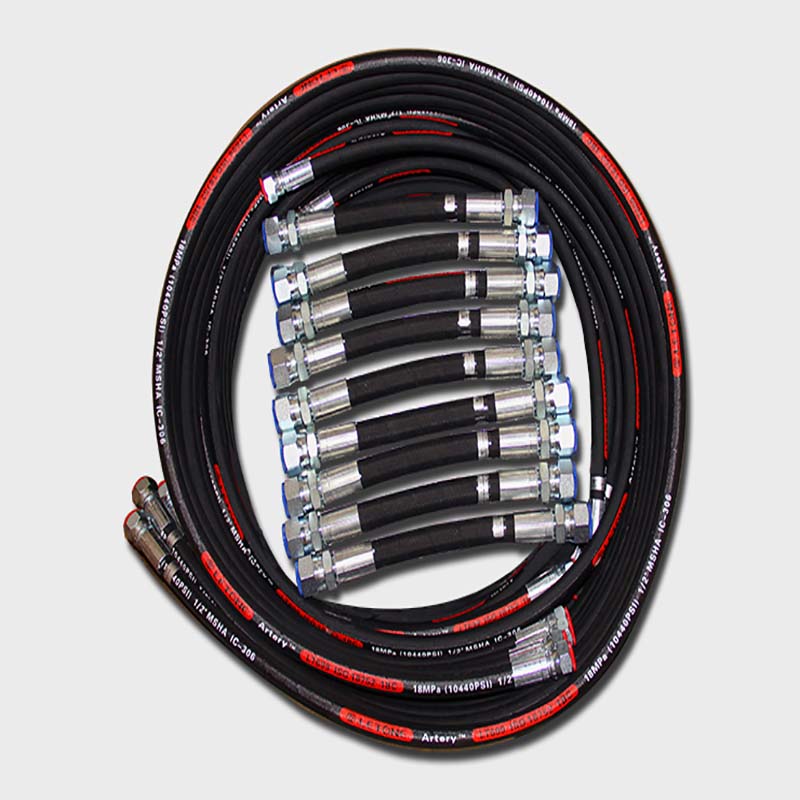In many fields such as oil exploration, geological drilling, and hydraulic coal mining, high-pressure drilling tubing (API tubing) plays an indispensable role as a key component. They are not only a bridge connecting equipment and drill bits, but also an important guarantee for ensuring the smooth progress of drilling operations. This article will delve into the structural characteristics, application areas, technological innovations, and future development trends of high-pressure drilling hoses, providing you with a comprehensive understanding of the "blood vessels" in this industrial field.
Structural characteristics of high-pressure drilling hose
High pressure drilling hoses, also known as drilling rubber hoses or drilling equipment hoses, have complex and precise structures designed to meet various challenges in extreme working environments. Generally speaking, drilling hoses consist of an inner rubber layer, a reinforcement layer, and an outer rubber layer. Some high-end products also use stainless steel armored inner pipes to enhance pressure resistance.
Inner rubber layer: usually made of high-strength synthetic rubber, it has good oil resistance, wear resistance, and chemical corrosion resistance, ensuring smooth transmission of internal fluids such as water, mud, compressed air, or hydraulic oil.
Reinforcement layer: This is the core part of the rubber hose, woven from multiple layers of steel wire or carbon fiber, providing strong compressive, tensile, and torsional resistance, allowing the hose to remain stable under high pressure and complex stress conditions.
Outer rubber layer: Covering the reinforcement layer, it mainly serves as a protective layer to prevent external wear and corrosion, while increasing the wear resistance and weather resistance of the rubber hose.
In addition, high-pressure drilling hoses also have unique advantages in drilling operations, such as physiological inertness, UV resistance, ozone resistance, high and low temperature resistance (-80 to 300 degrees), strong rebound force, and flame retardancy.
application area
High pressure drilling hoses are widely used in fields such as petroleum exploration, geological drilling, mineral extraction, and water conservancy engineering. In oil exploration, they are used on drilling platforms to connect the drilling machine to the wellhead, transport drilling fluid (mud) to the drill bit, and ensure the continuity and efficiency of drilling operations. Meanwhile, in geological drilling, drilling hoses also undertake important tasks such as transporting mud, cooling drill bits, and flushing rock debris.
Specifically, the core role of drilling hoses in drilling operations includes:
1. Flexible connection: A flexible connection is made between the top of the drilling riser and the vertically movable faucet, effectively absorbing vibration and displacement and protecting the equipment from damage.
2. High pressure conveying: Under high pressure conditions, a large amount of water-based or oil-based mud pumped out from rotary drilling equipment is transported to ensure the smooth progress of drilling operations.
3. Anti hydrogen sulfide corrosion: Some high-end drilling hoses also have the ability to prevent hydrogen sulfide corrosion, ensuring the safety of operations in sulfur-containing formations.
Technological Innovation and Future Prospects
With the advancement of technology and the continuous improvement of industrial demand, the technology of high-pressure drilling hoses is also constantly innovating and developing. The application of new materials, optimized structural design, and the introduction of intelligent control technology have led to a qualitative leap in the performance of rubber hoses.
The application of new materials, such as the introduction of nanocomposites, significantly improves the wear resistance and chemical corrosion resistance of rubber hoses, extending their service life.
Structural optimization: By optimizing the structure and material ratio of the reinforcement layer, the compressive strength and fatigue resistance of the rubber hose have been improved, making it more adaptable to complex and changing drilling environments.
Intelligent monitoring: The introduction of intelligent monitoring systems enables real-time monitoring of the working status of rubber hoses, early warning of potential faults, and ensuring job safety.
In the future, with the deepening of the concepts of green, low-carbon, and sustainable development, the high-pressure drilling hose industry will also pay more attention to environmental protection and sustainability. By developing more environmentally friendly materials, optimizing production processes, and improving resource utilization, we aim to drive the industry towards a greener and more efficient direction.
epilogue
As a key component in drilling operations, the performance of high-pressure drilling hoses directly affects the safety, efficiency, and cost of the operation. Through continuous technological innovation and product upgrades, high-pressure drilling hoses will play a more important role in future industrial development, contributing greater strength to the development and utilization of human resources. We believe that in the near future, more advanced, efficient, and environmentally friendly high-pressure drilling hoses will continue to emerge, injecting new vitality into the prosperous development of the drilling industry.

